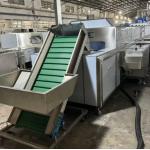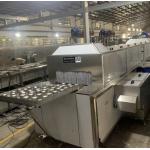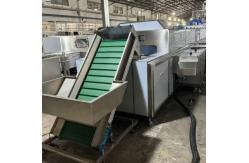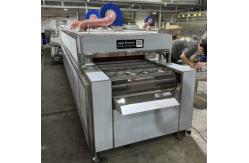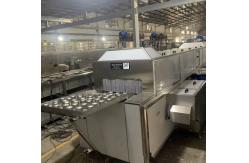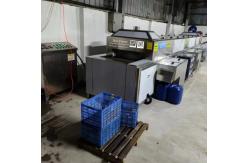Powerful Cleaning Ability Automated Cleaning And Drying Equipment
Production Line Working process: Loading → Aerated pickling and rust removal → Ultrasonic chemical
cleaning → Ultrasonic chemical cleaning → Ultrasonic water cleaning
→ Ultrasonic water cleaning + dehydration → Hot air drying → Hot
air drying → Unloading. The production line of automated cleaning and drying equipment with
powerful cleaning ability usually operates in the following steps: Feeding stage: - Automatic conveying: Items to be cleaned are smoothly conveyed to
the entrance of the cleaning and drying equipment production line
through specific conveying devices such as conveyor belts and
roller conveyors.
- Material pretreatment: For items with severe surface dirt or
special materials, pretreatment may be required before
feeding.
Cleaning stage:
- Selection of cleaning methods: According to factors such as the
material, shape, and type of dirt of items, the production line
will choose different cleaning methods. Common cleaning methods
include:
- High-pressure water jet cleaning: Using the powerful pressure water
flow generated by a high-pressure water pump to scour the surface
of items, which can quickly remove dust, sediment, oil stains and
other dirt attached to the item surface.
- Ultrasonic cleaning: Generating high-frequency sound waves through
an ultrasonic generator, forming millions of tiny bubbles in the
cleaning liquid. When these bubbles burst, they will generate
strong impact force and can quickly peel off the dirt on the
surface and in the gaps of items. Suitable for cleaning precision
parts, electronic components and other items with high cleanliness
requirements.
- Chemical cleaning: Using specific chemical cleaning agents to react
with dirt to achieve the purpose of cleaning.
- Dry ice cleaning: Spraying dry ice particles at high speed onto the
item surface. After dry ice contacts an object, it will sublimate
instantly, and its volume will expand hundreds of times. The
generated impact force can remove dirt from the item surface.
- Cleaning liquid circulation and filtration: During the cleaning
process, the cleaning liquid needs to continuously circulate to
ensure the uniformity and stability of the cleaning effect.
- Cleaning time and temperature control: According to the cleaning
requirements of items and different cleaning methods, the
production line will precisely control the cleaning time and
temperature.
Rinsing stage:
- Multiple rinsing: Items after cleaning usually need to be rinsed to
remove residual cleaning agents and dirt. The rinsing process may
be carried out multiple times, and the water used is usually
purified pure water to ensure the cleanliness of items.
- Water quality monitoring and control: During the rinsing process,
the production line will monitor the water quality of the rinsing
water in real time to ensure that the water quality meets the
cleaning requirements. If the water quality is not up to standard,
the system will automatically change the water or purify the
water.
Drying stage:
- Hot air drying: Using the hot air generated by a hot air blower to
dry the cleaned items. The temperature, wind speed, and drying time
of the hot air can be adjusted according to the material and drying
requirements of items.
- Vacuum drying: Placing items in a vacuum environment and rapidly
evaporating the moisture on the item surface by reducing air
pressure. Vacuum drying is suitable for items with high drying
requirements and easy oxidation.
- Infrared drying: Using the thermal radiation effect of infrared
rays to heat and dry items. Infrared drying has the advantages of
fast heating speed, high energy utilization rate, and no damage to
the item surface. It is often used in production lines with high
drying speed requirements.
Discharging stage:
- Automatic output: After cleaning and drying, items are
automatically conveyed to the discharging port of the production
line through a conveying device. At the discharging port, a
detection device may be equipped to detect the cleaning and drying
effects of items. If unqualified products are found, they will be
automatically removed or processed again.
- Packaging and storage: For some items that need packaging, after
discharging, they will directly enter the packaging link for
packaging and storage.
Equipment Parameters: Tank Body
Structure | Internal effective size | Inner tank size: L2600×W1400×H500mm
Approximate overall size: L2850W1650H750mm (subject to the actual size) | | Heating method | Electric heating 12KW | | Material | The inner tank adopts "SUS304" 2.5mm Zhangjiagang Posco stainless
steel plate.
The non-radiating surface adopts SUS304 T = 2.0mm, and the outer
door panel adopts 1.0mm stainless steel. | | Outer frame of the cleaning tank | It is fabricated by welding stainless steel 40401.5 square tubes, with a sturdy and durable structure. | | Structure | The ultrasonic transducers are adhered to the bottom of the tank
(bottom vibration type), and four corner wheels are configured at
the bottom. | | Ultrasonic transducer | Adopt imported wafer transducers of "HESEN" brand and imported
bonding technology. The total number of ultrasonic transducers is
200, with a frequency of 28KHZ and 60W each. | | | Total ultrasonic power | 12KW | | | Time control | It is built-in in the generator and the time is adjustable from 0
to 999 minutes. | | Power supply system | Ultrasonic generator | The generator adopts 4 sets of internationally leading IGBT modules
and power tubes for control to ensure strong and stable output
power. Xiantai's unique sweeping frequency technology ensures no
dead corners in cleaning.
It has functions such as continuously adjustable power, sweeping
frequency, timing adjustment, start/stop, etc. | | Component part | All are imported high-quality components. | | Other | | Configure a dedicated control box rack. There are two independent
generators placed on the control box rack.
The ultrasonic power cord is 3 meters long. | | After-sales服务sevre | Transport | | | The equipment is warranted for one year and maintained for life. |
|


